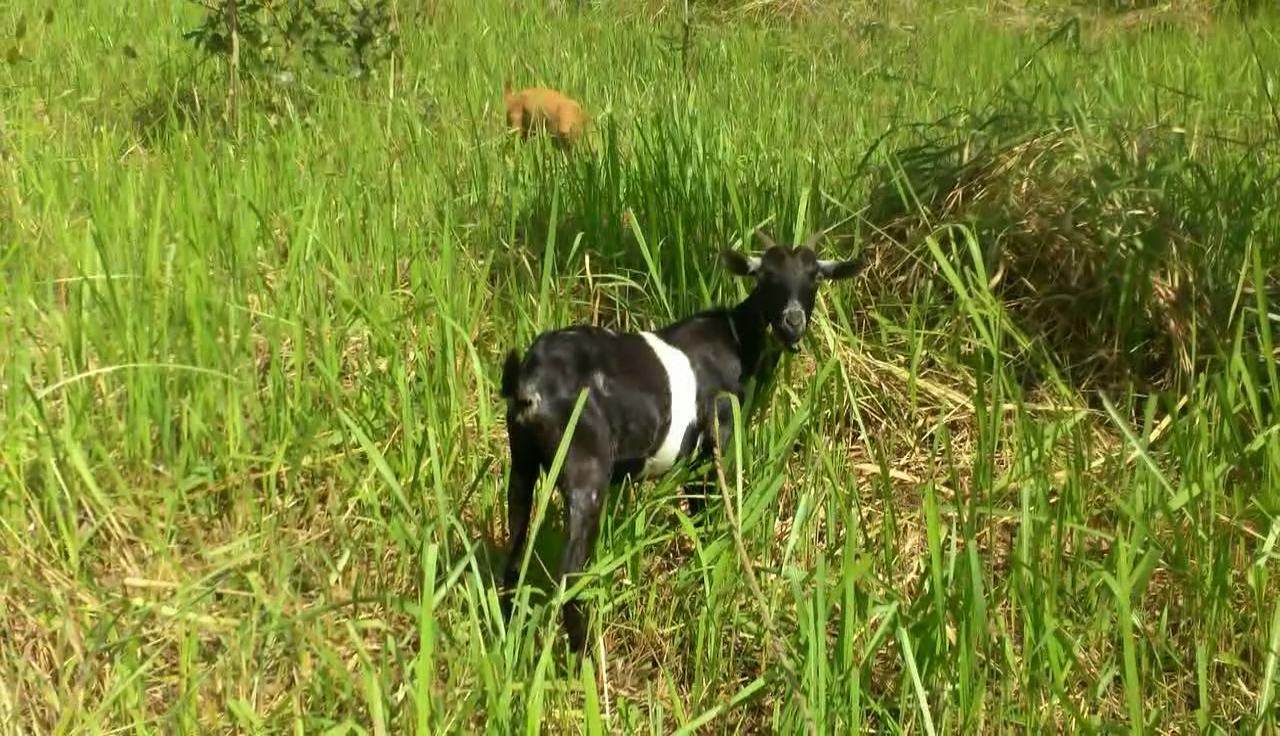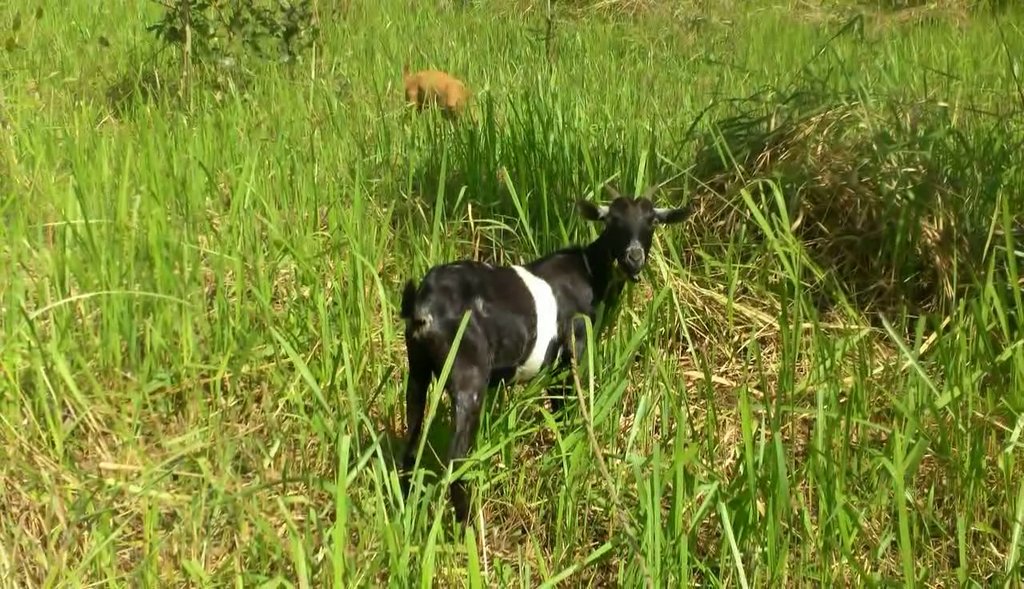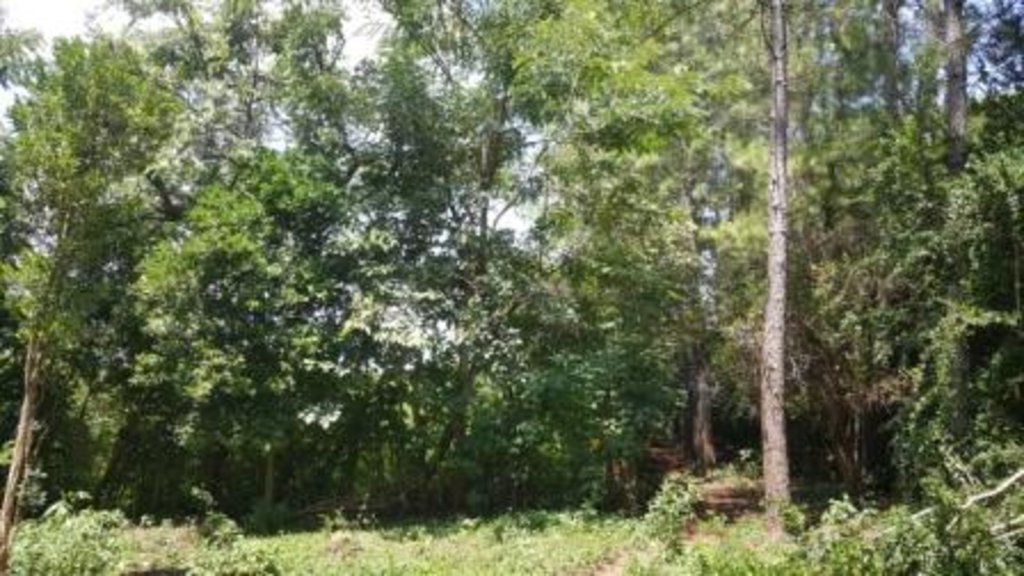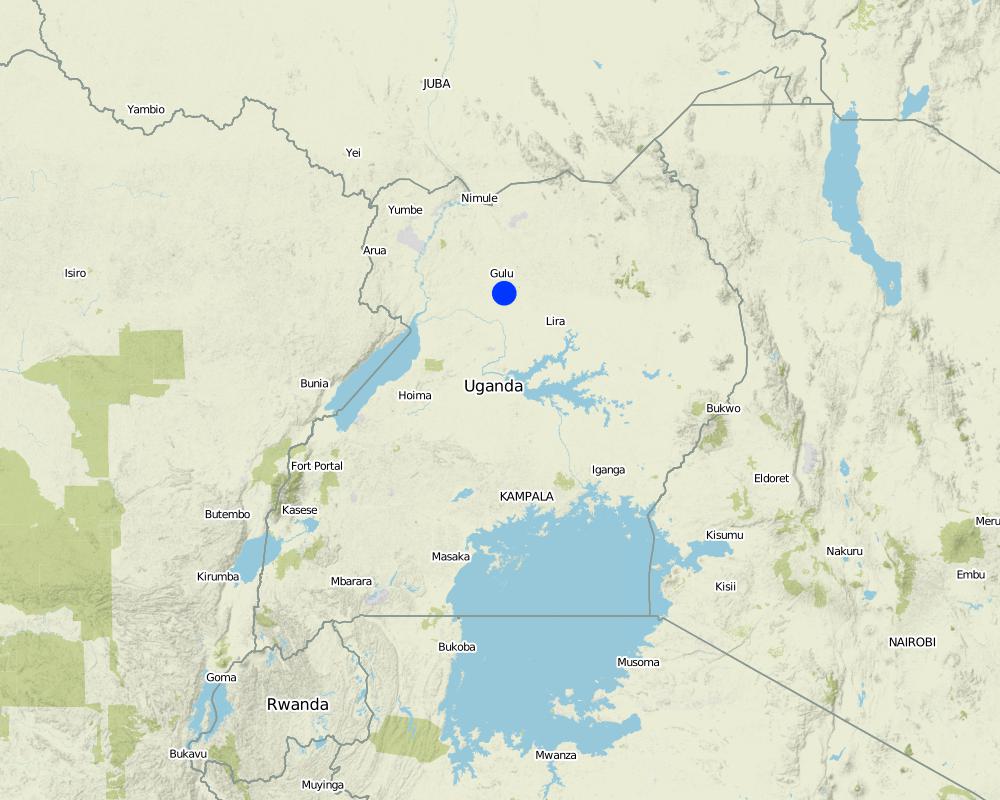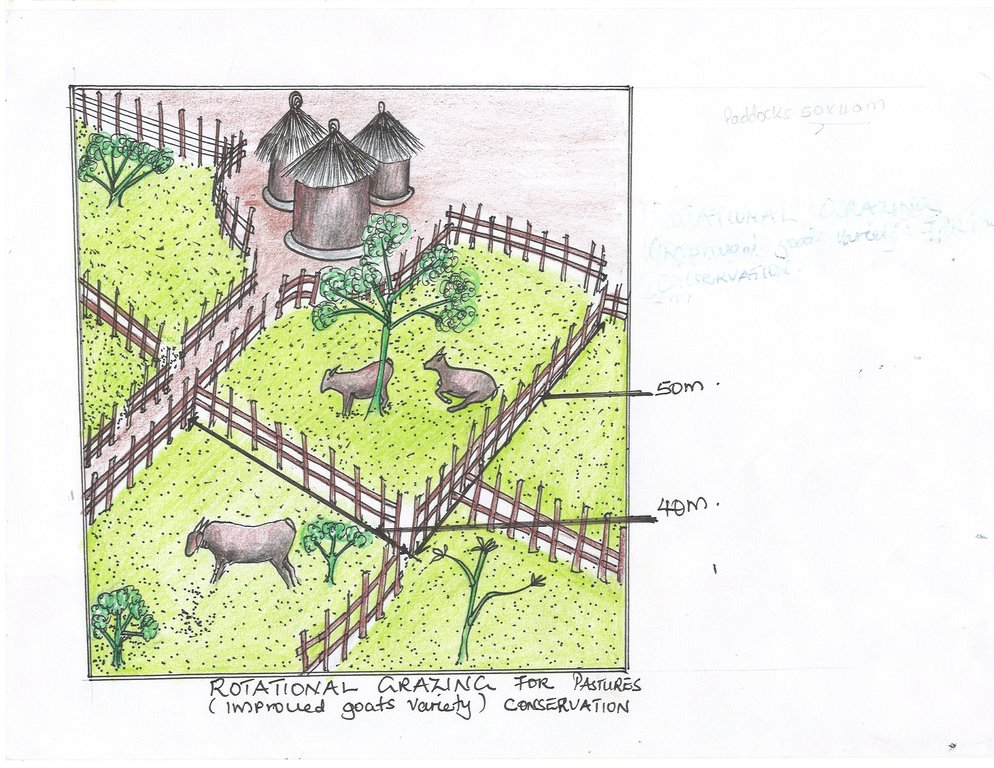Rotational grazing of goats for pasture conservation and improvement. [Ouganda]
- Création :
- Mise à jour :
- Compilateur : betty adoch
- Rédacteur : JOY TUKAHIRWA
- Examinateurs : Drake Mubiru, Nicole Harari, Renate Fleiner, Stephanie Jaquet, Rima Mekdaschi Studer, Alexandra Gavilano
Gwoko Dyel
technologies_2147 - Ouganda
Voir les sections
Développer tout Réduire tout1. Informations générales
1.2 Coordonnées des personnes-ressources et des institutions impliquées dans l'évaluation et la documentation de la Technologie
Personne(s)-ressource(s) clé(s)
exploitant des terres:
Mwaka Abel
Omoro district, Bobi subcounty, Paidwe parish, Pato village.
Ouganda
Nom du projet qui a facilité la documentation/ l'évaluation de la Technologie (si pertinent)
Scaling-up SLM practices by smallholder farmers (IFAD)Nom du ou des institutions qui ont facilité la documentation/ l'évaluation de la Technologie (si pertinent)
CDE Centre for Development and Environment (CDE Centre for Development and Environment) - Suisse1.3 Conditions relatives à l'utilisation par WOCAT des données documentées
Le compilateur et la(les) personne(s) ressource(s) acceptent les conditions relatives à l'utilisation par WOCAT des données documentées:
Oui
1.4 Déclaration sur la durabilité de la Technologie décrite
Est-ce que la Technologie décrite ici pose problème par rapport à la dégradation des terres, de telle sorte qu'elle ne peut pas être déclarée comme étant une technologie de gestion durable des terres?
Non
Commentaires:
Improves biodiversity in the grazing fields and improvement of soil fertility through rotational grazing where the goats wastes enhances soil fertility which enables the regeneration of natural pastures in the different paddocks.
2. Description de la Technologie de GDT
2.1 Courte description de la Technologie
Définition de la Technologie:
Rotational grazing by improved goats variety enhances/ increases soil fertility, biodiversity and production of pastures and generates farmyard manure applied on cropland.
2.2 Description détaillée de la Technologie
Description:
Rotational grazing is the shifting of livestock to different units of a pasture or range in regular sequence to permit the recovery and regrowth of the pasture plants after grazing, which increased forage production. Forage that are over-grazed or are less healthy from being grazed every few days have smaller root mass, which leads to less soil organic matter. Northern Uganda has tropical savannah climate characterized by moderate rainfall of 750-1000mm per annum. This region also experiences prolonged dry spells from June to July and also November to March characterised by wild fire outbreaks which retards pasture growth. Because of this, land user has to conserve pastures through rotational grazing in a paddock system. The land is gently sloping with moderate soil humus that has also supported the growth of pastures. The land user is a subsistence farmer who graze goat in a paddock system for pasture conservations, manure generation for cropland, and goats for home consumptions and sale. About 90% of his income is from on farm activities.
A well-managed controlled grazing program can increase quality forage production by 30-70% each year. Much of this increase in forage production is accomplished by minimizing overgrazing. In this technology, six paddocks were created measuring 40x50meters on a five acres’ piece of land. Goats are shifted from one paddock to another in an interval of one month and later shifted to another section. The water tank is also moved as the goats are shifted to another paddocks. The shifting is to reduce on overgrazing. The land user has 40 goats. Two paddocks are grazed at the same time with each having a carrying capacity of 20goats to minimize on overcrowding and congestion at the water point. controlled grazing is practiced in order to protect the area from the damages of grazing that is digging up roots and everything in the field since this will de-grass an area and make it susceptible for erosion. By limiting graze time, fields can produce all year round instead of being a one-time harvest. Goats are not allowed to graze a paddock until it is at least 10 to 12 inches in height. If grazed any shorter, this compromises root recovery, energy storage in the roots, and grass' ability to depend on photosynthesis alone. This is why the land user preferred rotational grazing to prevent overgrazing, and allow the forage plenty of time to recover.
The inputs needed for the establishment of this technology are pangas, hand hoes, slashers, poles, and labour force to carry out the work of paddock constructions. To main the technology, the over grown grass is slashed to a height of 10 to 12 inches in height which is consumable by goats, water point is cleaned every two weeks to avoid contamination, paddocks repaired and goats constantly checked for treatment
The technology provides beneficial impacts like improvement of organic matter content and pasture soil fertility as a result of spreading manure around the whole pasture while grazing and browsing. Grazing goats typically return to the water tanks or a single favourite shade tree. The manure deposited around water tanks/tree shade is collected and used as farmyard manure for the seasonal crop production like cereals, vegetables, and legumes.
The technology is disliked because it is tedious to look after so many goats, wild animal attacks and drought affects water supply and pasture growth for the goats.
2.3 Photos de la Technologie
2.4 Vidéos de la Technologie
Commentaire, brève description:
Goats grazing in the natural pastures
Date:
28/04/2017
Lieu:
Omoro District, Bobi Sub County, Paidwe Parish, Pato Village.
Nom du vidéaste:
Betty Adoch
2.5 Pays/ région/ lieux où la Technologie a été appliquée et qui sont couverts par cette évaluation
Pays:
Ouganda
Région/ Etat/ Province:
Northern Uganda.
Autres spécifications du lieu:
Omoro District.
Spécifiez la diffusion de la Technologie:
- répartie uniformément sur une zone
S'il n'existe pas d'informations exactes sur la superficie, indiquez les limites approximatives de la zone couverte:
- 0,1-1 km2
Commentaires:
The GPS point shows the land user grazing ground. Rotational grazing.
Map
×2.6 Date de mise en œuvre de la Technologie
Indiquez l'année de mise en œuvre:
2003
Si l'année précise est inconnue, indiquez la date approximative: :
- il y a entre 10-50 ans
2.7 Introduction de la Technologie
Spécifiez comment la Technologie a été introduite: :
- grâce à l'innovation d'exploitants des terres
Commentaires (type de projet, etc.) :
Diversify source of income, improve on nutrition and improve soil fertility.
3. Classification de la Technologie de GDT
3.1 Principal(aux) objectif(s) de la Technologie
- réduire, prévenir, restaurer les terres dégradées
- conserver/ améliorer la biodiversité
- s'adapter au changement et aux extrêmes climatiques et à leurs impacts
- atténuer le changement climatique et ses impacts
- créer un impact économique positif
- créer un impact social positif
3.2 Type(s) actuel(s) d'utilisation des terres, là où la Technologie est appliquée

Terres cultivées
- Cultures annuelles
Cultures annuelles - Précisez les cultures:
- céréales - maïs
- céréales - sorgho
- simsim
Nombre de période de croissance par an: :
- 2
Précisez:
Rainfall is moderate which sustains pasture growth.

Pâturages
Pâturage intensif/ production fourragère :
- Prairies améliorées
- Rotational grazing
Type d'animal:
- bétail - bovins à viande
- caprine
- volailles
- The goats graze the paddocks twice a year.
Espèces:
bétail - bovins à viande
Nombre:
8
Espèces:
caprine
Nombre:
40
Espèces:
volailles
Nombre:
50
Commentaires:
conservation of pastures
3.4 Approvisionnement en eau
Approvisionnement en eau des terres sur lesquelles est appliquée la Technologie:
- pluvial
Commentaires:
Rainfall is moderate which sustains pasture growth.
3.5 Groupe de GDT auquel appartient la Technologie
- système de rotation (rotation des cultures, jachères, agriculture itinérante)
- gestion intégrée cultures-élevage
3.6 Mesures de GDT constituant la Technologie

pratiques agronomiques
- A1: Couverture végétale/ du sol
- A2: Matière organique/ fertilité du sol

modes de gestion
- M1: Changement du type d’utilisation des terres
- M2: Changement du niveau de gestion / d'intensification
- M3: Disposition/plan en fonction de l'environnement naturel et humain

autres mesures
Commentaires:
The mixed cropland is easily managed with livestock which provides manures to the cropland leading to high crop yields and pasture conservation.
3.7 Principaux types de dégradation des terres traités par la Technologie

érosion hydrique des sols
- Wt: perte de la couche superficielle des sols (couche arable)/ érosion de surface

dégradation physique des sols
- Pc: compaction

dégradation biologique
- Bc: réduction de la couverture végétale
- Bs: baisse de la qualité et de la composition/ diversité des espèces
Commentaires:
high risks of fire outbreaks and prolonged dry spells.
3.8 Prévention, réduction de la dégradation ou réhabilitation des terres dégradées
Spécifiez l'objectif de la Technologie au regard de la dégradation des terres:
- prévenir la dégradation des terres
- réduire la dégradation des terres
Commentaires:
To promote diversification and prevent land degradation.
4. Spécifications techniques, activités, intrants et coûts de mise en œuvre
4.1 Dessin technique de la Technologie
Spécifications techniques (associées au dessin technique):
Five acres of land under paddock system of rotational grazing. The paddocks measures 40x50meter. Poles of about 1meter high are used to fenced the paddocks.
Auteur:
Betty Adoch
Date:
28/04/2017
4.2 Informations générales sur le calcul des intrants et des coûts
Spécifiez la manière dont les coûts et les intrants ont été calculés:
- par superficie de la Technologie
Indiquez la taille et l'unité de surface:
5acres
autre/ monnaie nationale (précisez):
UGX
Indiquez le taux de change des USD en devise locale, le cas échéant (p.ex. 1 USD = 79.9 réal brésilien): 1 USD = :
3718,0
Indiquez le coût salarial moyen de la main d'œuvre par jour:
1000shs
4.3 Activités de mise en place/ d'établissement
| Activité | Calendrier des activités (saisonnier) | |
|---|---|---|
| 1. | Clearning the bush through digging and slashing | Dry season. |
| 2. | Marking the paddocks and planting poles | Dry season |
| 3. | Fencing the area | Dry season |
| 4. | Installing the water tank | Dry season |
| 5. | Introducing the goats into the paddock | Rainy season |
Commentaires:
Easy to eastablish rotational grazing.
4.4 Coûts et intrants nécessaires à la mise en place
Commentaires:
The cost is manageable by the land user.
4.5 Activités d'entretien/ récurrentes
| Activité | Calendrier/ fréquence | |
|---|---|---|
| 1. | Slashing the over grown grass | wet season |
| 2. | cleaning the water tank | wet and dry season |
| 3. | Refilling the water tank | wet and dry season |
| 4. | Repairing the paddock | Dry season |
| 5. | Creating firelines | dry season |
Commentaires:
The land user protects his farm from the danger of fire outbreaks and pests.
4.6 Coûts et intrants nécessaires aux activités d'entretien/ récurrentes (par an)
Commentaires:
Record keeping is not done by the farmer.
4.7 Facteurs les plus importants affectant les coûts
Décrivez les facteurs les plus importants affectant les coûts :
The labour costs for fencing the paddocks, and the high costs of fencing materials.
5. Environnement naturel et humain
5.1 Climat
Précipitations annuelles
- < 250 mm
- 251-500 mm
- 501-750 mm
- 751-1000 mm
- 1001-1500 mm
- 1501-2000 mm
- 2001-3000 mm
- 3001-4000 mm
- > 4000 mm
Spécifications/ commentaires sur les précipitations:
The rainfall is moderate and unreliable.
Indiquez le nom de la station météorologique de référence considérée:
Gulu meterological station.
Zone agro-climatique
- subhumide
Climate is suitable for pasture growth.
5.2 Topographie
Pentes moyennes:
- plat (0-2 %)
- faible (3-5%)
- modéré (6-10%)
- onduleux (11-15%)
- vallonné (16-30%)
- raide (31-60%)
- très raide (>60%)
Reliefs:
- plateaux/ plaines
- crêtes
- flancs/ pentes de montagne
- flancs/ pentes de colline
- piémonts/ glacis (bas de pente)
- fonds de vallée/bas-fonds
Zones altitudinales:
- 0-100 m
- 101-500 m
- 501-1000 m
- 1001-1500 m
- 1501-2000 m
- 2001-2500 m
- 2501-3000 m
- 3001-4000 m
- > 4000 m
Indiquez si la Technologie est spécifiquement appliquée dans des:
- situations convexes
Commentaires et précisions supplémentaires sur la topographie:
The landscape is generally gentle easy to practice rotational grazing.
5.3 Sols
Profondeur moyenne du sol:
- très superficiel (0-20 cm)
- superficiel (21-50 cm)
- modérément profond (51-80 cm)
- profond (81-120 cm)
- très profond (>120 cm)
Texture du sol (de la couche arable):
- moyen (limoneux)
Texture du sol (> 20 cm sous la surface):
- grossier/ léger (sablonneux)
Matière organique de la couche arable:
- moyen (1-3%)
5.4 Disponibilité et qualité de l'eau
Profondeur estimée de l’eau dans le sol:
5-50 m
Disponibilité de l’eau de surface:
bonne
Qualité de l’eau (non traitée):
eau potable
La salinité de l'eau est-elle un problème? :
Non
La zone est-elle inondée?
Non
Commentaires et précisions supplémentaires sur la qualité et la quantité d'eau:
suitable for human consuptions and animals .
5.5 Biodiversité
Diversité des espèces:
- élevé
Commentaires et précisions supplémentaires sur la biodiversité:
Different species of plants and animals coexist in the environment.
5.6 Caractéristiques des exploitants des terres appliquant la Technologie
Sédentaire ou nomade:
- Sédentaire
Orientation du système de production:
- exploitation mixte (de subsistance/ commerciale)
Revenus hors exploitation:
- moins de 10% de tous les revenus
Niveau relatif de richesse:
- moyen
Individus ou groupes:
- individu/ ménage
Niveau de mécanisation:
- traction animale
Genre:
- hommes
Age des exploitants des terres:
- personnes d'âge moyen
Indiquez toute autre caractéristique pertinente des exploitants des terres:
He totally depends on farming for livelihood.
5.7 Superficie moyenne des terres utilisées par les exploitants des terres appliquant la Technologie
- < 0,5 ha
- 0,5-1 ha
- 1-2 ha
- 2-5 ha
- 5-15 ha
- 15-50 ha
- 50-100 ha
- 100-500 ha
- 500-1 000 ha
- 1 000-10 000 ha
- > 10 000 ha
Cette superficie est-elle considérée comme de petite, moyenne ou grande dimension (en se référant au contexte local)?
- petite dimension
5.8 Propriété foncière, droits d’utilisation des terres et de l'eau
Propriété foncière:
- individu, avec titre de propriété
Droits d’utilisation des terres:
- individuel
Droits d’utilisation de l’eau:
- communautaire (organisé)
Commentaires:
The technologies secure the land from land grabbers within the community. The land user has full right over his land.
5.9 Accès aux services et aux infrastructures
santé:
- pauvre
- modéré
- bonne
éducation:
- pauvre
- modéré
- bonne
assistance technique:
- pauvre
- modéré
- bonne
emploi (par ex. hors exploitation):
- pauvre
- modéré
- bonne
marchés:
- pauvre
- modéré
- bonne
énergie:
- pauvre
- modéré
- bonne
routes et transports:
- pauvre
- modéré
- bonne
eau potable et assainissement:
- pauvre
- modéré
- bonne
services financiers:
- pauvre
- modéré
- bonne
6. Impacts et conclusions
6.1 Impacts sur site que la Technologie a montrés
Impacts socio-économiques
Production
production fourragère
Quantité avant la GDT:
negative
Quantité après la GDT:
positive
Commentaires/ spécifiez:
Due to conserved pastures.
Disponibilité et qualité de l'eau
disponibilité de l'eau potable
Quantité avant la GDT:
negative
Quantité après la GDT:
positive
Commentaires/ spécifiez:
Source of water is secured by the land user.
disponibilité de l'eau pour l'élevage
Quantité avant la GDT:
slightly negative
Quantité après la GDT:
very positive
Commentaires/ spécifiez:
Water filled in a tank for goats consumption.
qualité de l'eau pour l'élevage
Quantité avant la GDT:
negative
Quantité après la GDT:
positive
Commentaires/ spécifiez:
Goats fenced off which avoid water contamination.
Revenus et coûts
revenus agricoles
Quantité avant la GDT:
negative
Quantité après la GDT:
positive
Commentaires/ spécifiez:
Rotational grazing has saved the land user from purchasing animal feeds which would be very expensive.
Impacts socioculturels
connaissances sur la GDT/ dégradation des terres
Quantité avant la GDT:
negative
Quantité après la GDT:
very positive
Commentaires/ spécifiez:
Land user is aware of climate smart agriculture which has a lots of site benefits in terms of increased animal productions.
Impacts écologiques
Cycle de l'eau/ ruissellement
évaporation
Quantité avant la GDT:
very positive
Quantité après la GDT:
very negative
Commentaires/ spécifiez:
Grass cover the soil from effects of evaporation.
Sols
humidité du sol
Quantité avant la GDT:
negative
Quantité après la GDT:
positive
Commentaires/ spécifiez:
Grass covers the soil from erosion.
couverture du sol
Quantité avant la GDT:
slightly negative
Quantité après la GDT:
very positive
Commentaires/ spécifiez:
Grass covers the soil from being exposed to agents of erosion.
perte en sol
Quantité avant la GDT:
very positive
Quantité après la GDT:
very negative
Commentaires/ spécifiez:
The grass covers the soil from erosion.
compaction du sol
Quantité avant la GDT:
very positive
Quantité après la GDT:
very negative
Commentaires/ spécifiez:
Grazing goats loosen the soil particles which helps in fertile soil formation.
Biodiversité: végétale, animale
biomasse/ au dessus du sol C
Quantité avant la GDT:
negative
Quantité après la GDT:
very positive
Commentaires/ spécifiez:
Dry grass decompose to form humus.
diversité végétale
Quantité avant la GDT:
negative
Quantité après la GDT:
positive
Commentaires/ spécifiez:
Different vegetation covers exist in the grazing fields.
Réduction des risques de catastrophe et des risques climatiques
risques d'incendies
Quantité avant la GDT:
very positive
Quantité après la GDT:
very negative
Commentaires/ spécifiez:
Fire lines are created during dry seasons to prevent wildfire spread to the grazing fields.
6.2 Impacts hors site que la Technologie a montrés
capacité tampon/de filtration
Quantité avant la GDT:
negative
Quantité après la GDT:
positive
Commentaires/ spécifiez:
Grass roots filters and purifies the surface water.
dommages sur les champs voisins
Quantité avant la GDT:
positive
Quantité après la GDT:
negative
Commentaires/ spécifiez:
Goats are fenced off from crop land reducing unnecessary destruction.
impact des gaz à effet de serre
Quantité avant la GDT:
high
Quantité après la GDT:
low
Commentaires/ spécifiez:
conserved vegetation acts as carbon sink
Précisez l'évaluation des impacts extérieurs (sous forme de mesures):
The technology is highly sustainable.
6.3 Exposition et sensibilité de la Technologie aux changements progressifs et aux évènements extrêmes/catastrophes liés au climat (telles que perçues par les exploitants des terres)
Commentaires:
The technology is sustainable.
6.4 Analyse coûts-bénéfices
Quels sont les bénéfices comparativement aux coûts de mise en place (du point de vue des exploitants des terres)?
Rentabilité à court terme:
légèrement positive
Rentabilité à long terme:
positive
Quels sont les bénéfices comparativement aux coûts d'entretien récurrents (du point de vue des exploitants des terres)?
Rentabilité à court terme:
légèrement positive
Rentabilité à long terme:
positive
Commentaires:
The farmer has been able to generate income to improve his standard of living.
6.5 Adoption de la Technologie
- 1-10%
De tous ceux qui ont adopté la Technologie, combien d'entre eux l'ont fait spontanément, à savoir sans recevoir aucune incitation matérielle, ou aucune rémunération? :
- 0-10%
Commentaires:
The technology has inspired many community members to engage in sustainable land management practices.
6.6 Adaptation
La Technologie a-t-elle été récemment modifiée pour s'adapter à l'évolution des conditions?
Oui
Si oui, indiquez à quel changement la Technologie s'est adaptée:
- changements/ extrêmes climatiques
Spécifiez l'adaptation de la Technologie (conception, matériaux/ espèces, etc.):
indegineous pastures are conserved for the goats.
6.7 Points forts/ avantages/ possibilités de la Technologie
| Points forts/ avantages/ possibilités du point de vue de l'exploitant des terres |
|---|
| Conserve indegineous pastures. |
| The vegetation roots filters the surface water. |
| Points forts/ avantages/ possibilités du point de vue du compilateur ou d'une autre personne ressource clé |
|---|
| Availability of pastures for the goats through out the year. |
| The paddocks protects the land from land wrangles. |
6.8 Faiblesses/ inconvénients/ risques de la Technologie et moyens de les surmonter
| Faiblesses/ inconvénients/ risques du point de vue de l’exploitant des terres | Comment peuvent-ils être surmontés? |
|---|---|
| Limited capital to establish the paddocks. | Extenal support from doners. |
| Prolonged dry spells that retards pastures growth. | Practice climate smart agriculture like rotational grazing. |
| Faiblesses/ inconvénients/ risques du point de vue du compilateur ou d'une autre personne ressource clé | Comment peuvent-ils être surmontés? |
|---|---|
| Limited labour force to look after the goats. | Employing farm workers. |
| Pests and diseases that disturb the goats. | Technical services from the extension workers. |
7. Références et liens
7.1 Méthodes/ sources d'information
- visites de terrain, enquêtes sur le terrain
one
Quand les données ont-elles été compilées (sur le terrain)?
28/04/2017
7.2 Références des publications disponibles
Titre, auteur, année, ISBN:
Mixed crop-livestock farming - FAO
Disponible à partir d'où? Coût?
www.fao.org/docrep/004/Y0501E/y0501e03.htm
7.3 Liens vers les informations pertinentes en ligne
Titre/ description:
Mixed farming | ClimateTechWiki
URL:
www.climatetechwiki.org/content/mixed-farming
Liens et modules
Développer tout Réduire toutLiens
Aucun lien
Modules
Aucun module trouvé


